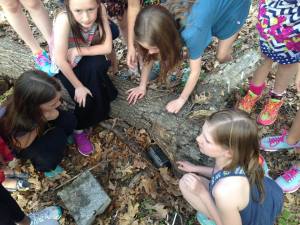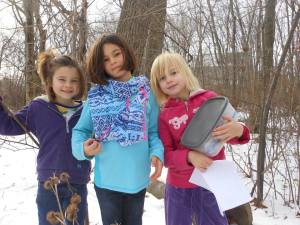 Both Letterboxing and Geocaching are free, worldwide hobbies that are open to anyone. For Girl Scouts who want to get in on the action, Brownies can earn the Letterboxer badge and Juniors can earn the Geocacher badge. Both badges give girls the opportunity to find boxes (and other types of containers) hidden all over the place. Its a great way to get outdoors and explore a forest or the city streets. Girls can earn these badges on their own but it is also fun to earn them as a troop.
Both Letterboxing and Geocaching are free, worldwide hobbies that are open to anyone. For Girl Scouts who want to get in on the action, Brownies can earn the Letterboxer badge and Juniors can earn the Geocacher badge. Both badges give girls the opportunity to find boxes (and other types of containers) hidden all over the place. Its a great way to get outdoors and explore a forest or the city streets. Girls can earn these badges on their own but it is also fun to earn them as a troop.
Letterboxer Brownie Badge – Click here for requirements
Atlas Quest describes letterboxing as combining “artistic ability with ‘treasure-hunts’ in parks, forests, and cities around the world. Participants seek out hidden letterboxes by cracking codes and following clues. The prize: an image from a miniature piece of art known as a rubber stamp—usually a unique, hand-carved creation.” In order to find the letterboxes near you go to Atlas Quest and register for a free account.
 To earn the Letterboxer badge, Brownies must complete the following steps:
To earn the Letterboxer badge, Brownies must complete the following steps:
- Learn about the letterboxing by learning the special terms letterboxers use and/or practicing hiding objects and coming up with clues to find them. A list of letterboxing lingo is available on the Glossary on the Atlas Quest website.
- Find a rubber stamp to use to identify yourself. If you don’t already have a stamp, you can either make one or buy one.
- Practicing solving clues, such as word scrambles or number codes. One way to complete this step by solving the puzzle that is a part of The Poppies of Flanders letterbox, in preparation for going out to find it. After you decode the clue you can find this letterbox near the corner of Playstead Road and Winthrop St. (Note: this is a puzzle that Brownies could decode themselves, once you explain how it works.)
- Search for a letterbox. Happily, Medford is chalk-a-block full of hidden letterboxes just waiting to be discovered. Here are a few suggested ones to get you started:
- Remembering Jumbo is located on the campus of Tufts University. It is an ideal box to look for as a troop because the girls can run all over the campus without crossing roads or getting lost.
- That Wise Old Owl is located in the Robbins Library in Arlington Center, so it is accessible in all seasons.
- The Cave of the Unpeppered Leopard is located at the Panther Cave in the Fells.
- Make a letterbox. For this final step, girls can simply make a letterbox for their friends or family to find, or they can plant a public letterbox and add it to Atlas Quest for the general public to find. Check out the Flying Unicorn Power letterbox for an example of one that a Brownie troop in Wilmington planted.
Many of the letterboxes in the Medford area (including most of the ones referenced above) were carved and planted by “Parhelia,” a local librarian. If you are looking for an expert, she willing to come and speak with Medford Brownie troops to introduce them to letterboxing. Click here to link to her profile page and send her a message.
Geocacher Junior Badge – Click here for requirements
What is Geocaching? It is like letterboxing but, instead of following clues to find the hidden object, you follow the GPS coordinates. Geocaching is a bit more difficult than letterboxing because some of the caches are tricky to find, so it makes sense that this badge is aimed at Juniors (that said, there are lots of easy geocaches that Brownies, or even Daisies, could find.) To get started, go to Geocaching.com and set up a free account. You will also need to download the Geocaching app to your smart phone, or use a separate GSP receiver. There is a basic geocaching app for free but, if you get into it, you have the option of paying for a premium membership and the premium app. The premium membership will allow you to see more caches and the premium app allows you to save the GPS instructions so you can use them offline.
Here are the steps required for Juniors to earn the Geocacher badge:
- Learn about geocaching. The easiest way to do this is to watch the cute instructional videos on the Geocaching 101 website. Another fun way to learn about geocaching is to watch some of the videos by the Geocaching Vlogger on YouTube.
- Learn how to use the GPS receiver or Geocaching app. You can complete this step by figuring out the GPS coordinates for various objects in your neighborhood. To take it to the next level, find an object in your neighborhood, note the GPS coordinates, and then give the coordinates to a friend or family member and tell them to find the object using the GPS coordinates.
- Make a trade item. When geocaches are large enough, you may find small trinkets in them. Geocaching etiquette states that you can trade for these items with something of equal or greater value, watch this 2-minute video for more info. Get ready to trade by making some small items. Simple crafts such as rainbow loom, friendship bracelets, or fuse beads work perfectly, but you can make anything. Here’s a video made by little kids about how to make friendship pins on safety pins, for example.
- Find a geocache! Here are some fun ones in the Medford area to get you started:
- Big Rock on Pine Hill is near Wright’s Tower in the Fells. It is a great example of a cleverly disguised geocache. It is large enough for tradables.
- This one is called Ship Yard Way right in Medford Square. It’s too small for tradables but it is a good example of an urban cache. If you get stuck, look at the hint, the previous logs, and the photos for clues.
- Here’s one called Parked on the east side of Medford, in Logan Park near Washington St. Once again, this one is too small for tradables but it is another common example of a very small cache.
- In West Medford, there’s a cache called Guinea Pig that is large enough to hold tradables.
 Create a Travel Bug and release it into the world. Travel bugs are small items that get picked up and dropped off from cache-to-cache. For a more comprehensive explanation, watch this 3-minute video from Geocaching.com. The picture to the right is of a Girl Scout themed Travel Bug that was launched by Medford Junior Troop 75198 earlier this year.
Create a Travel Bug and release it into the world. Travel bugs are small items that get picked up and dropped off from cache-to-cache. For a more comprehensive explanation, watch this 3-minute video from Geocaching.com. The picture to the right is of a Girl Scout themed Travel Bug that was launched by Medford Junior Troop 75198 earlier this year.
